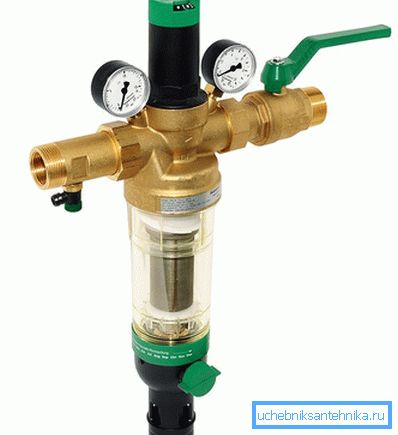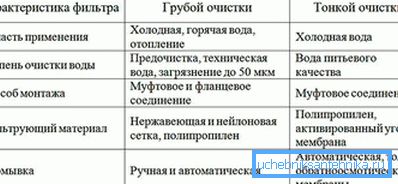Coarse and fine water filters
Our health depends on the quality of water in the house, as well as the timing of the operation of sanitary equipment and household appliances that are connected to the water supply. Water that enters the house, whether it is tap water or from a well, contains insoluble impurities (iron scales, rust, grains of sand, particles of winding to seal joints) and other contaminants. All impurities are harmful to health, and cause irreparable damage to household and plumbing. To avoid this, water treatment systems for coarse and fine cleaning are installed.
Coarse filters

Prefilter or coarse filters can trap particles larger than 90–100 µm. They are installed at the entrance of the water supply network to the house as the first stage of purification of drinking water. Used for hot and cold water and heating. As the filter material is used stainless steel mesh, nylon mesh or polypropylene fiber. The filter housing is made of durable plastic or corrosion-resistant metal.
Most filters are flow-through. They are set perpendicular to the flow. The flask should be placed vertically and directed downwards, with the flow direction from the bottom up, you need to foresee a horizontal section for the installation of the filter.
The type of connection of cleaning systems - flanged or coupling - depends on the method of insertion into the pipeline.
Filters with flange connection are used on pipelines of 50 mm and more. Used for installation on large consumers.
Depending on the cleaning method, filter systems are:
- with automatic washing;
- with manual washing.

The filtering material in systems with manual washing is made of stainless steel mesh or nylon. In the filters with automatic washing in the bottom of the flask is a drain valve. Washing is performed by direct or reverse flow of water. To do this, open the drain valve and close the valve in front of the filter. Wash water is discharged into the sewer.
Manual flush filters, which include a skew filter, should be disassembled and cleaned from time to time.
Some coarse filters are equipped with pressure gauges and pressure control valves that protect the system from water hammering.
Fine filters

Fine cleaning systems perform one function, but can be multifunctional. The former remove impurities from water in the size from 5 to 50 microns. The latter are able to purify water from odors, heavy metal ions, organochlorine compounds, nitrates and nitrites. These include reverse osmosis and sorption filters.
The difference between fine and coarse filters: the first in the process of operation they purify water to a high quality, and the filtering material (cartridge) must be replaced. The exceptions are reverse-osmosis and some mesh. The flask of fine filters is most often made of plastic.
Fine filters are installed only after coarse filters, otherwise they quickly become clogged with large impurities and become unusable.
The most popular among the population received cleaning systems, with a filtering material from activated carbon (usually from coconut shell) with high adsorption properties. This type of filter retains undissolved impurities up to 10 microns and removes extraneous odors from the water, dissolved contaminants at the ion level.

The resource of such a filter depends on the quality of water, as well as on the lifetime. These water treatment devices are not subject to regeneration, they need to be changed after 6 months of use.
If the cartridge is not replaced in time, it will begin to give up all accumulated impurities to the drinking water. Some manufacturers produce cartridges that are treated with silver ions with antibacterial properties.
Of all the fine filters, the most effective water treatment systems are reverse osmosis. The principle of cleaning is the ability of the membrane to retain all contaminants. Purified, the water is divided into two streams: permeate - purified water, and the concentrate - water with a high salt content. The concentrate is discharged into the sewer, and the purified water enters the storage tank.

After cleaning, the water becomes almost distilled, and this is not very good for health. Therefore, after the membrane, you need to install a mineralizer that saturates water with useful minerals to the desired concentration.
The membrane is the main and most expensive element of the system. Service life is more than 3 years.
A comparative review of coarse and fine filters is given in the table below:

Depending on financial possibilities, you can purchase coarse and fine cleaning devices that will best meet your customer requirements.
If you have additional recommendations on the selection of coarse and fine water filters, which were not mentioned in the article, write comments. Your experience can be useful for us and our readers.
Video
Some features of reverse osmosis systems and main filters are considered in the video: